The Real Deal on Pink Syngoniums: How to Keep Them Vibrant and Thriving
I’ve been working with tropical plants for a long, long time. My hands have been in the soil of thousands of them, from huge commercial operations to my own private collection. And I still remember the first time I saw a whole bench full of those intensely pink syngoniums. It wasn’t just a hint of pink; it was a loud, confident, bubblegum statement. That day, it really clicked for me: a plant’s color isn’t just pretty, it’s a billboard advertising its health and what it needs.
In this article
- First Things First: Picking a Winner (and What You’ll Need)
- Why Is It Pink? And What’s with the Arrow Shape?
- The Setup: Getting the Core Care Right
- Your 5-Minute Pink Syngonium Check-Up
- Growth & Maintenance: How to Shape Your Plant
- Making More Plants: It’s Easier Than You Think
- Troubleshooting: What Your Plant is Trying to Tell You
- A Critical Safety Warning: This Plant is Toxic
- A Final Word
- Galerie d’inspiration
A lot of guides just throw the basic instructions at you—water this, light that. But they don’t get into the ‘why.’ They don’t teach you how to read what the plant is trying to tell you. I’ve learned the hard way, like the time I scorched an entire batch of perfect plants by moving them into the sun too fast. But I’ve also brought some back from the absolute brink. So, let’s go beyond a simple care sheet. I want to share what I’ve learned from getting my hands dirty, so you can keep your pink arrowhead plant not just alive, but truly happy.
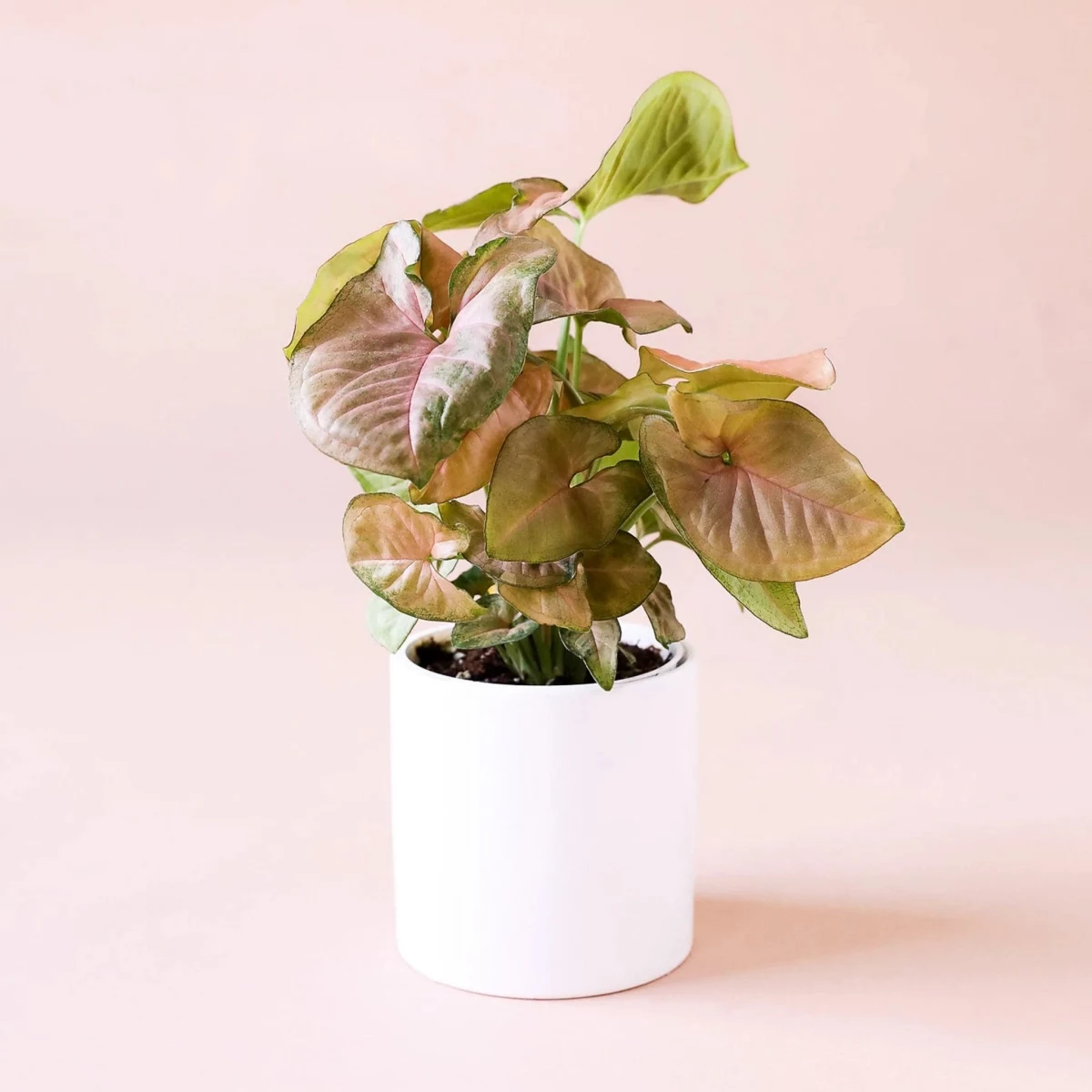
First Things First: Picking a Winner (and What You’ll Need)
Honestly, the best way to have a healthy plant is to start with one. When you’re at the garden center, be picky! Look for a plant with vibrant, firm leaves. Avoid any with brown crispy edges, yellowing leaves, or sad, wilted stems. Gently peek under a few leaves—if you see any tiny webs or white cottony specks, walk away. That’s a pest problem you don’t want to bring home.
Good to know: A healthy 4-inch pot will probably cost you between $15 and $25, while a larger, fuller 6-inch plant might be closer to $30 or $50, depending on where you shop.
To set yourself up for success, here’s a quick shopping list of what you’ll want to have on hand:
- The Plant: Your beautiful Pink Syngonium, of course!
- A Pot with Drainage: Make sure it has holes in the bottom. This is non-negotiable.
- The Right Soil: A chunky, well-draining aroid mix. You can buy this pre-made online or at a specialty nursery, or mix your own.
- A Watering Can: Or just a cup, anything to water it with.
- Optional but helpful: A small humidifier, some balanced liquid fertilizer, and clean pruners.
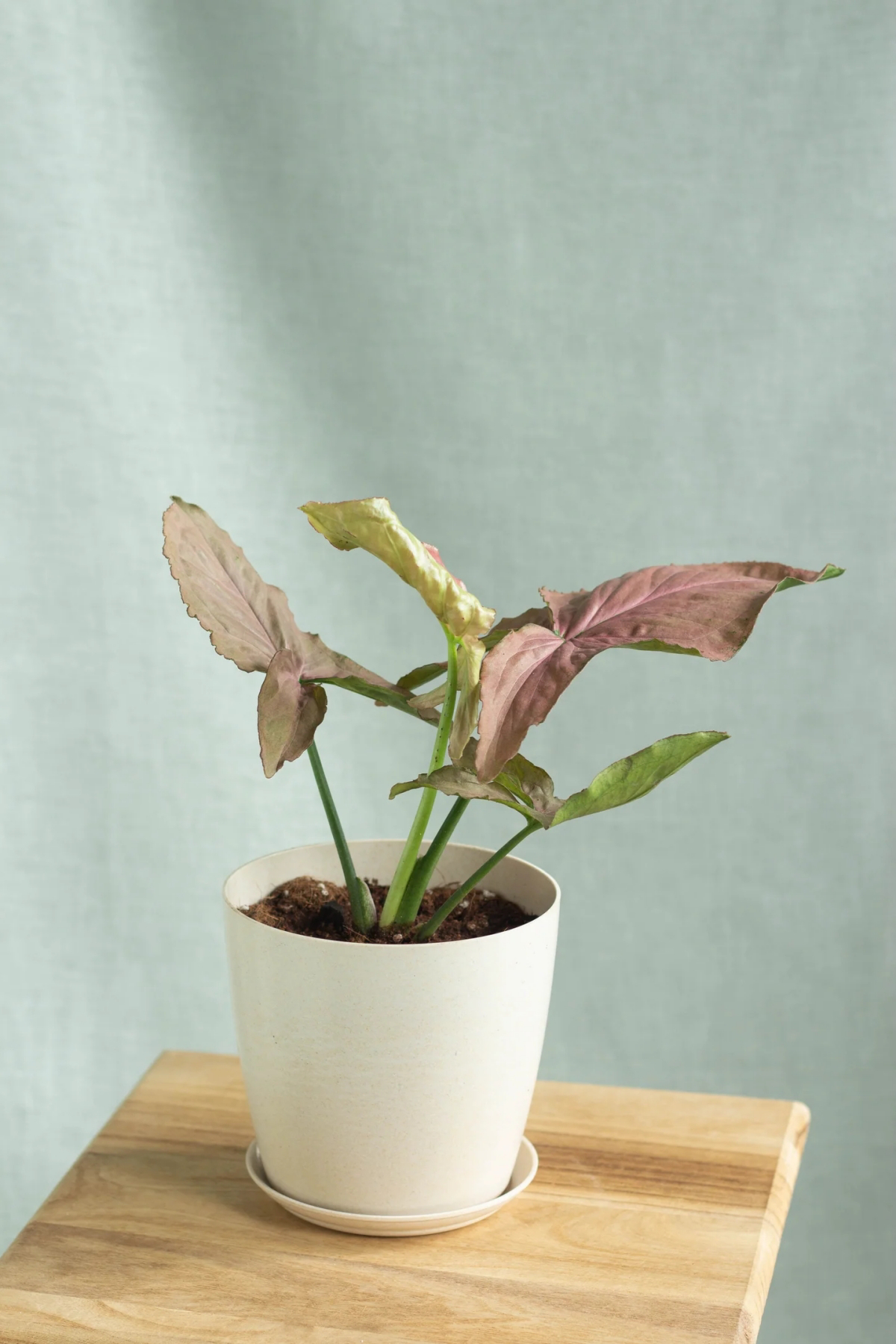
Why Is It Pink? And What’s with the Arrow Shape?
To really get this plant, you have to understand its personality. It’s part of a big plant family that includes Monsteras and Philodendrons, so it shares some family traits. (Heads up: One of those traits is toxicity, which we’ll cover later. It’s super important.)
The stunning pink color comes from pigments that, in the wild, often act like sunscreen. But in these cultivated varieties, the pink is the star of the show. It’s a type of variegation, which just means the leaf has areas with very little green chlorophyll. Chlorophyll is what lets the plant make food from light. So, a super pink leaf is gorgeous, but it’s kind of a freeloader, not contributing much energy. The plant relies on the greenish parts of its leaves to do all the work. This is the key to everything: your job is to find a lighting sweet spot that keeps the pink vibrant without letting the plant starve for light.
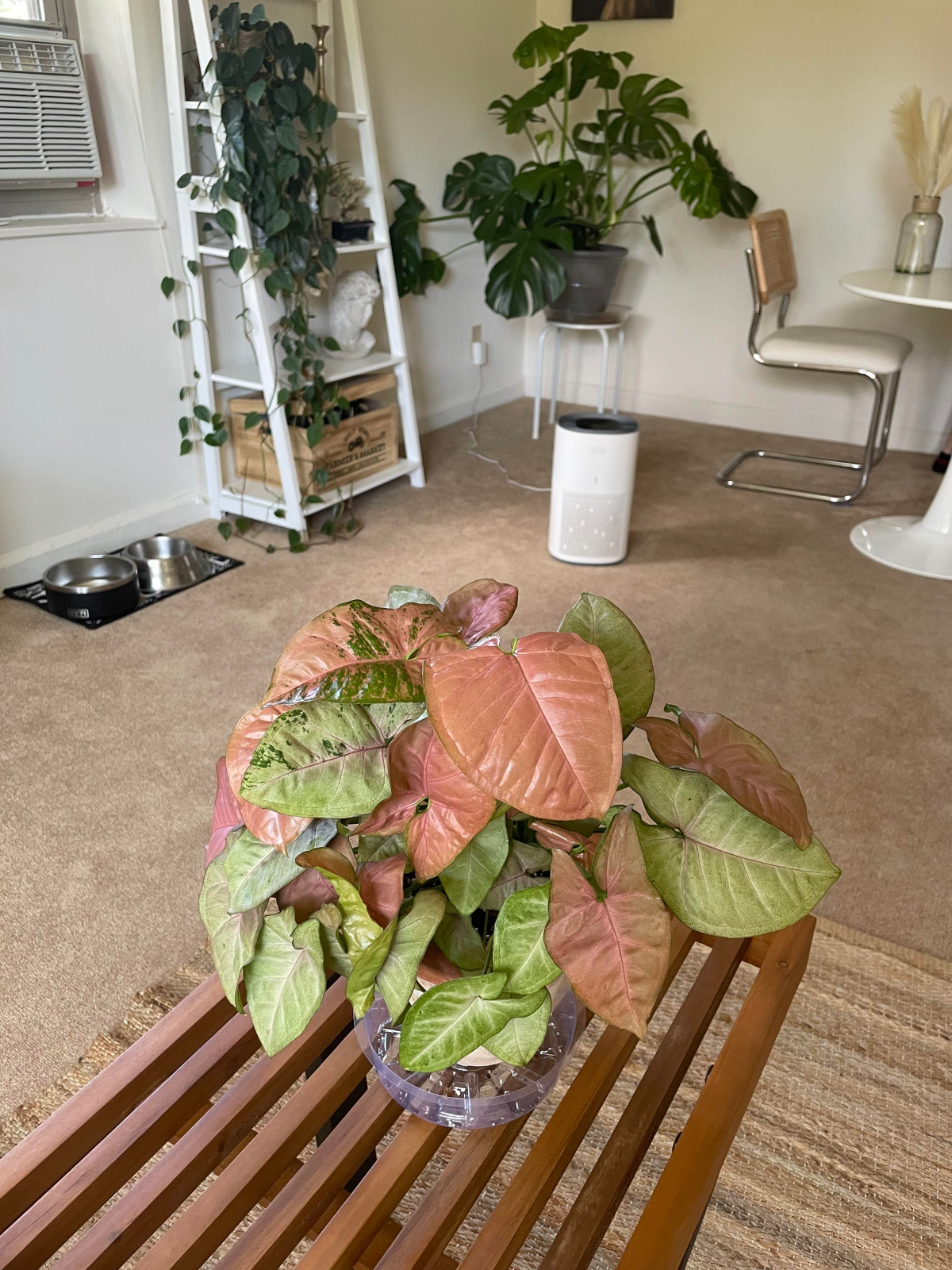
And that classic arrowhead shape? That’s its juvenile look. In the rainforest, young Syngoniums crawl along the ground looking for a tree to climb. Once they start climbing, they mature and their leaves change shape completely, becoming deeply lobed and looking almost like a different plant. At home, we keep them in their baby phase by pruning them. If you want a full, bushy plant, you’ll need to trim it. If you want a climber, you have to give it a pole to grow up.
The Setup: Getting the Core Care Right
Getting the environment right is 90% of the battle. A plant in the right spot is easy. A plant in the wrong spot will always be a struggle.
Light: The Secret to Staying Pink
This is where most people go wrong. The goal is bright, indirect light for at least six hours a day. Think of the kind of dappled light that filters through a canopy of trees.
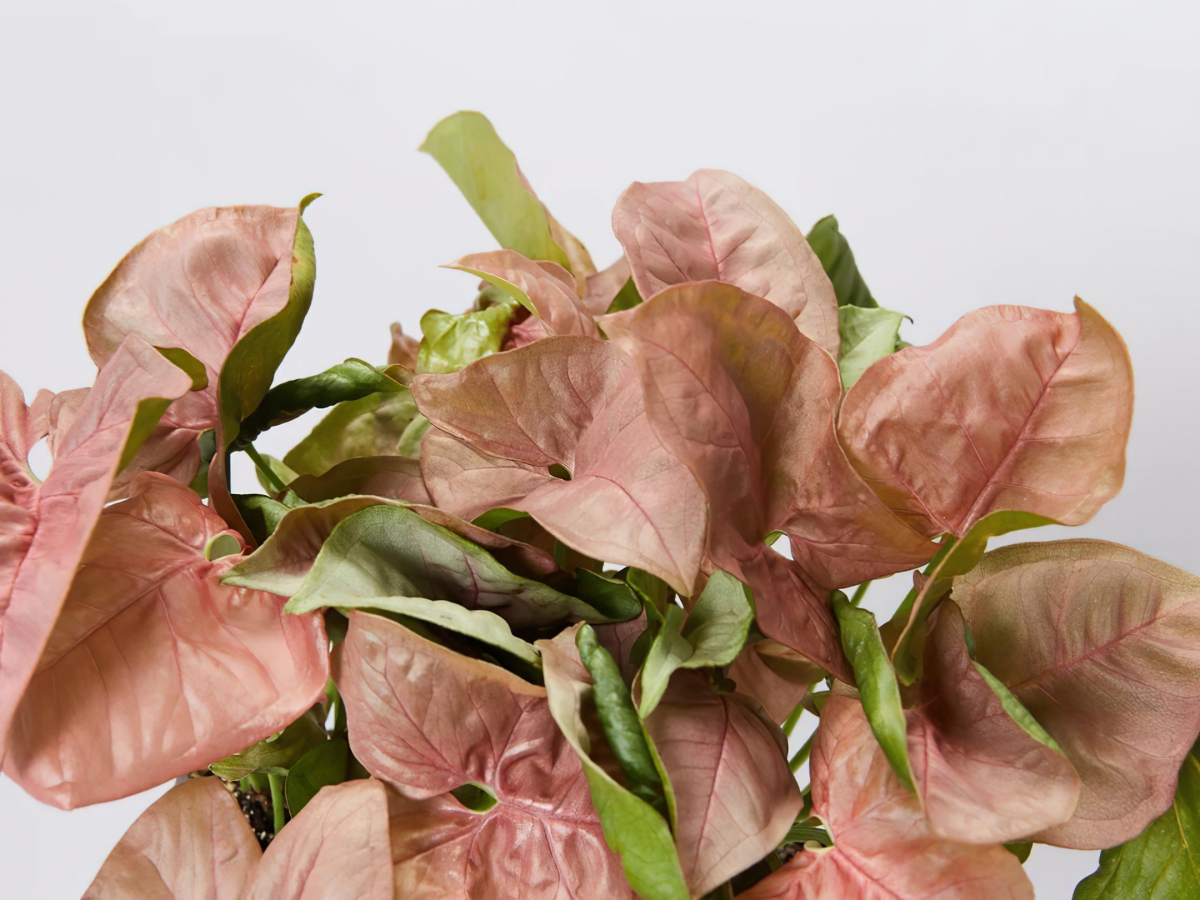
A spot a few feet from an east-facing window is usually the jackpot. It gets that soft morning sun that isn’t harsh enough to burn. A north-facing window can work, too, but you might find the pink fades a bit. If you only have a strong south or west-facing window, just hang a sheer curtain to diffuse the light. Problem solved.
Quick tip: Here’s a simple test the pros use. Hold your hand about a foot above the plant’s spot. A soft, fuzzy-edged shadow means the light is good. A sharp, dark shadow means it’s too direct and will scorch the leaves. Barely any shadow at all? It’s too dark, and your plant will likely start putting out greener leaves to compensate.
Watering: The Moist-But-Not-Soggy Dance
Syngoniums don’t like to be bone dry, but they absolutely despise sitting in a puddle. Soggy soil is the fast track to root rot, where the roots are starved of oxygen and basically drown. It’s the number one killer of these guys.
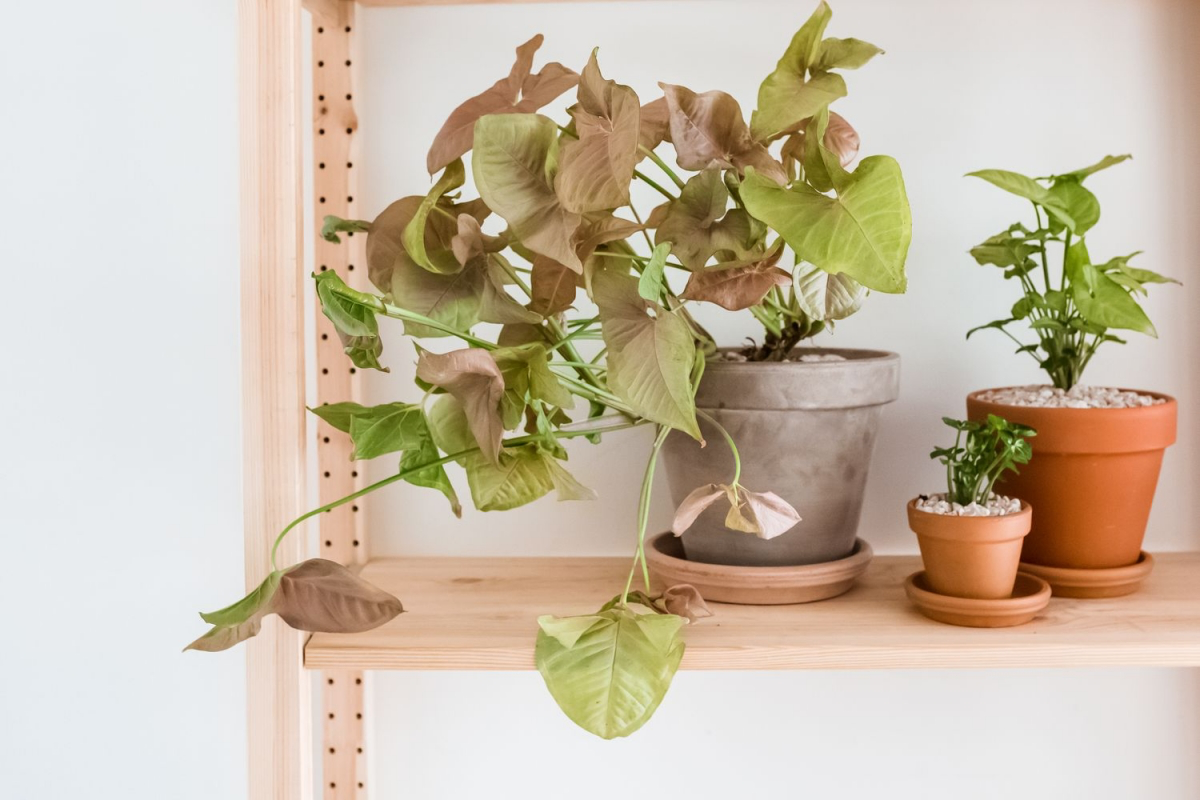
The technique is simple: when you water, do it thoroughly. Let water run all the way through the pot and out the drainage holes. Then, and this is the important part, dump out any excess water from the saucer. Don’t water it again until the top 1-2 inches of soil feel dry to the touch. The easiest way to check is to just stick your finger in there. Your finger is the best moisture meter you can own.
Soil: The Foundation for Healthy Roots
Please don’t use soil from your garden! It’s way too heavy and will compact around the roots, suffocating them. You need a light, airy mix that drains fast.
You can buy a commercial “aroid mix,” which is perfect. Or, you can easily make your own. My go-to recipe is simple: one part potting soil or coco coir, one part perlite, and one part orchid bark. The soil holds a bit of moisture, the perlite creates air pockets, and the bark gives it structure. A bag of perlite is usually under $10 and will last you for ages. This mix gives the roots room to breathe, which is the best defense against root rot.
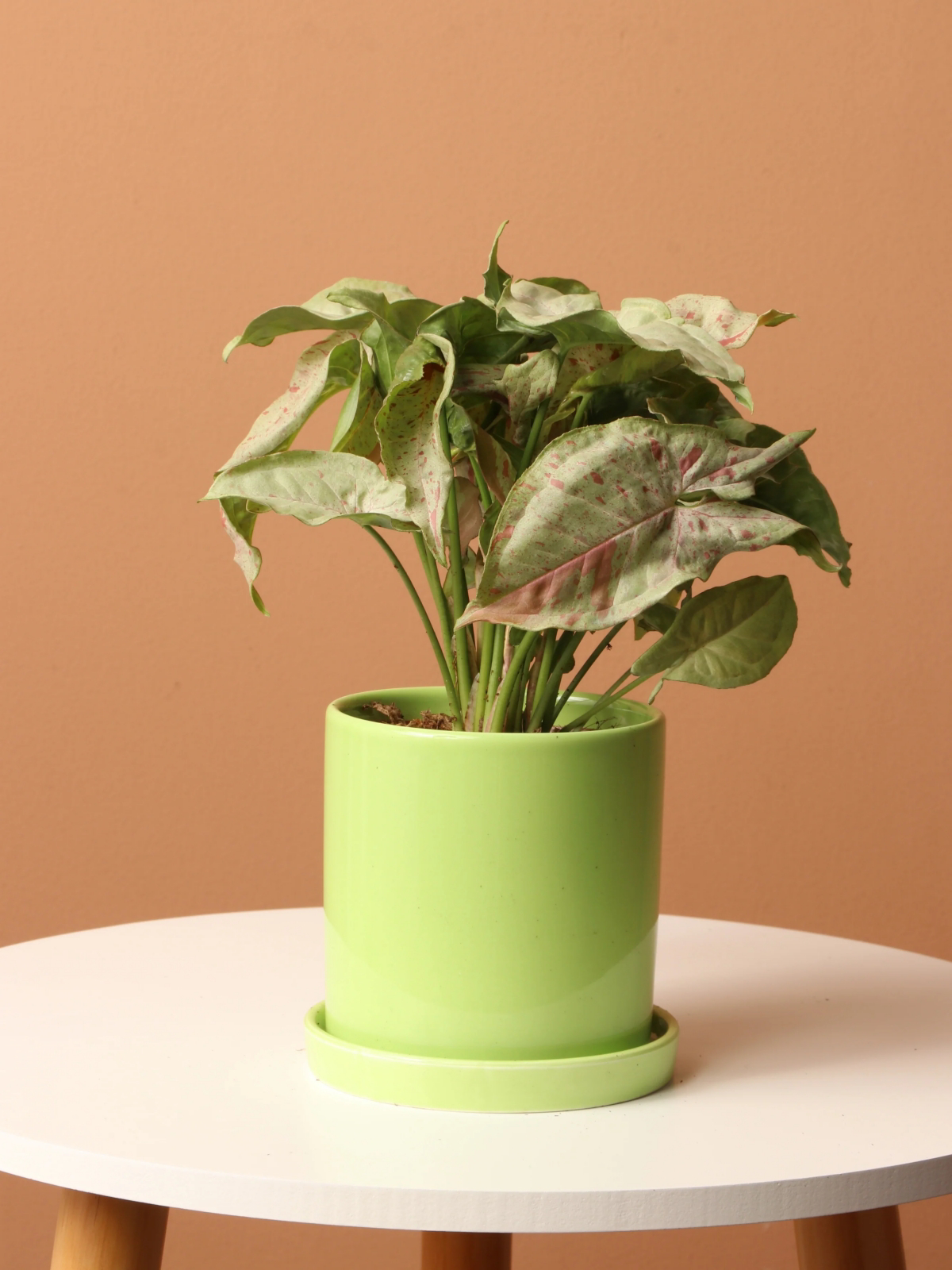
You’ll only need to repot every year or two. Don’t jump up to a giant pot; choose one that’s just 1-2 inches wider than the current one. A pot that’s too big holds too much soil, which stays wet too long, risking… you guessed it, root rot.
Humidity & Temperature: Making it Feel at Home
These are tropical plants, so they dig warmth and humidity. They’re happiest between 65°F and 80°F. Just keep them away from cold drafts, open windows in the winter, or direct blasts from a heating vent.
Most homes are drier than these plants prefer, especially in the winter. The easiest way to boost humidity is a small room humidifier. They can be found for as little as $20 online and make a huge difference. Grouping plants together or placing the pot on a tray of pebbles filled with water also helps. (Just make sure the pot is sitting on the pebbles, not in the water.)
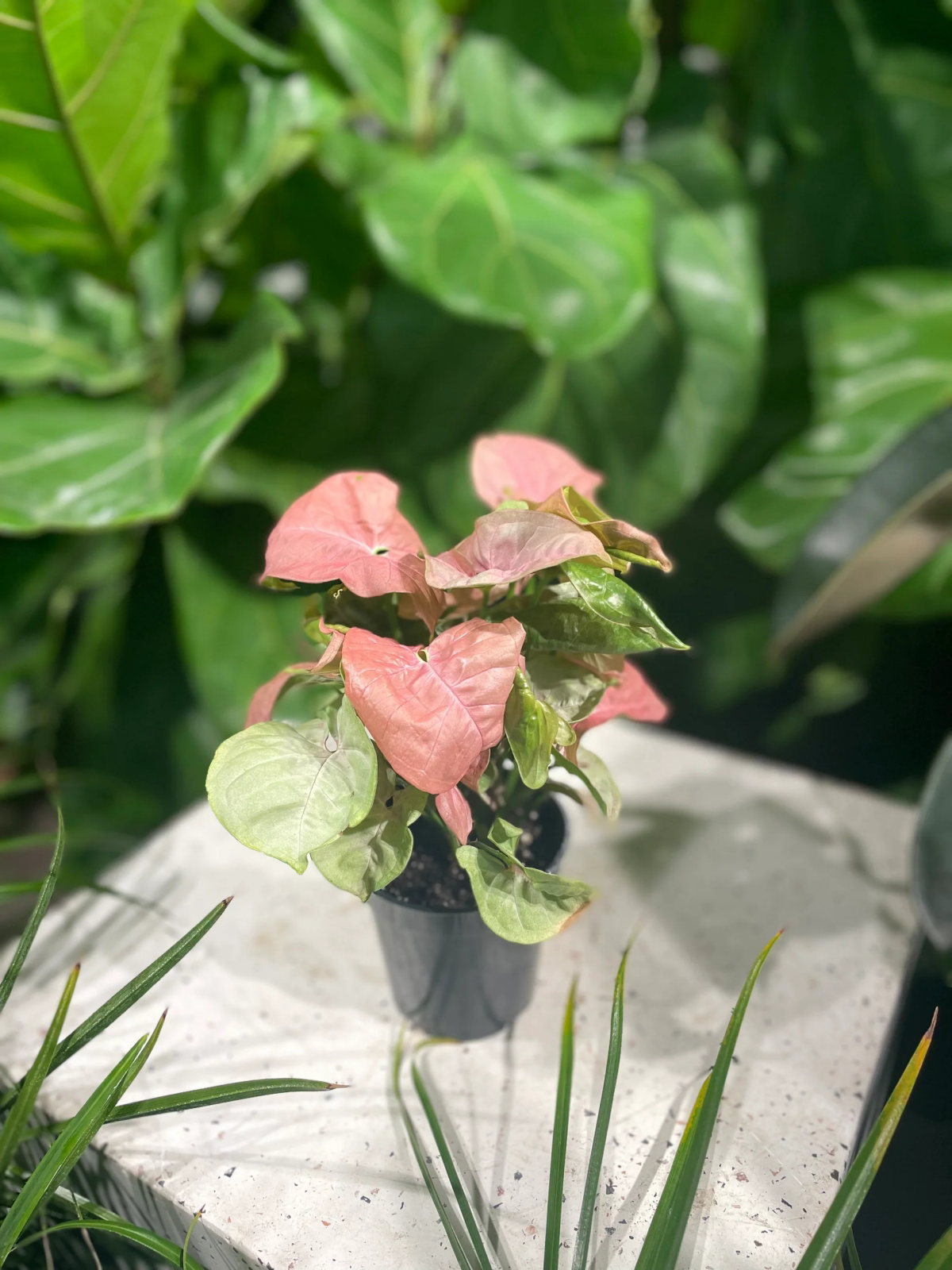
Your 5-Minute Pink Syngonium Check-Up
Feeling overwhelmed? Don’t be. Here are three simple things you can do right now to make your plant happier.
- 1. Give it a spin. Rotate the pot 180 degrees so the other side gets to face the light. This promotes even growth.
- 2. Do the finger test. Poke your finger into the soil. Is it dry a couple of inches down? Time to water. Still moist? Leave it alone.
- 3. Play detective. Gently lift up three different leaves and check underneath for any pests. Catching them early is everything.
Growth & Maintenance: How to Shape Your Plant
Feeding Your Plant
During spring and summer, your Syngonium is actively growing and appreciates a snack. But it’s easy to overdo it. I always recommend using a balanced liquid fertilizer (like a 10-10-10) but diluting it to half the strength recommended on the bottle. So, if the label says “1 teaspoon per gallon,” you’ll use just half a teaspoon per gallon. Easy. Feed it this weak mix every 4-6 weeks during the growing season, and always water the plant before you fertilize to avoid burning the roots. Stop fertilizing completely in the fall and winter when growth naturally slows.
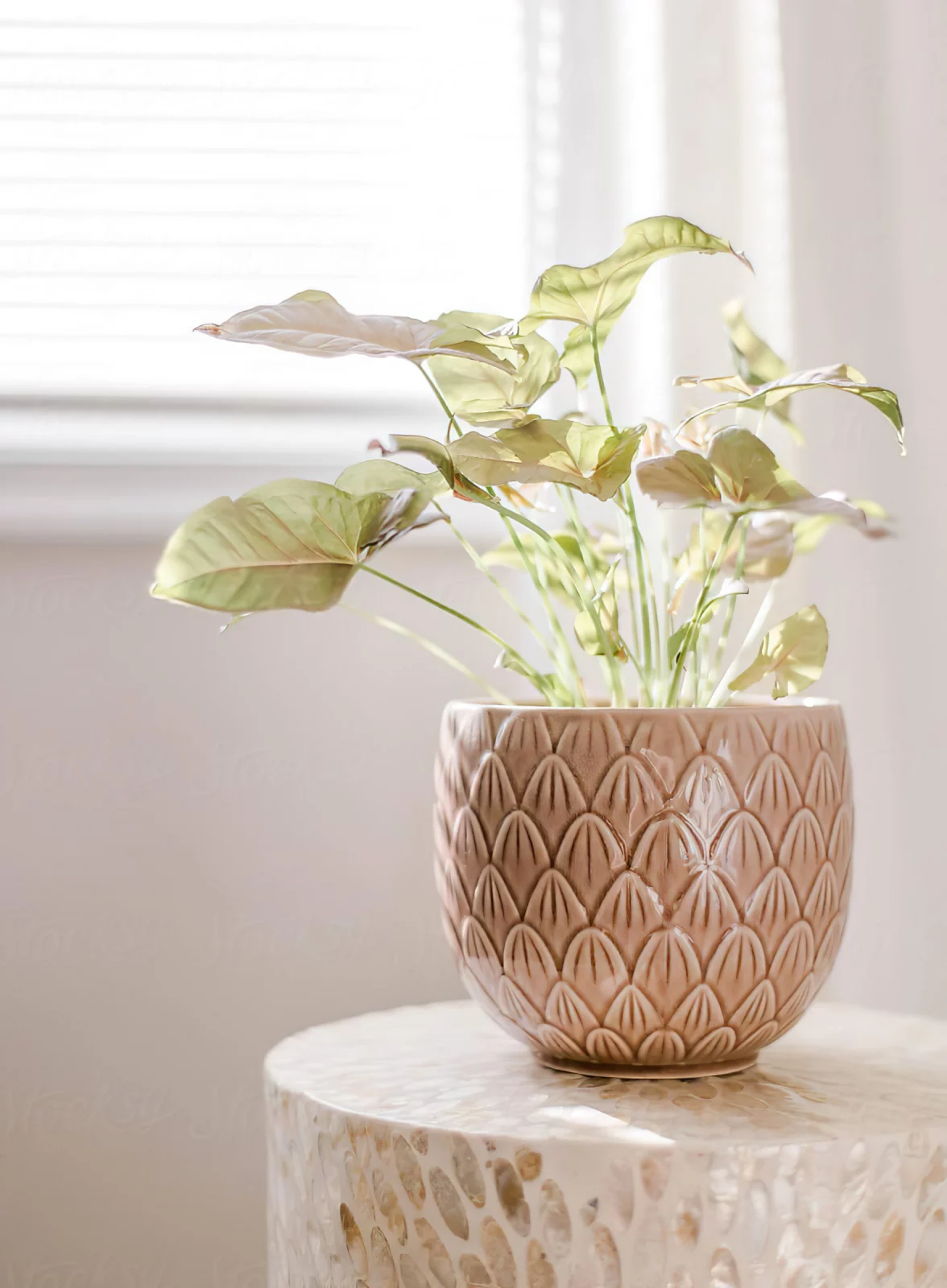
Pruning for a Bushy Plant or a Climber
Pruning is your way of telling the plant what to do. Don’t be scared! It actually encourages healthy, new growth. Always use clean, sharp scissors.
To keep it full and bushy, just trim back any of the long, vining stems. I cut them right above a node (the little bump on the stem where a leaf grows). This will force the plant to branch out from that point. You can do this whenever it starts to look a little sparse or “leggy.” You’ll know it’s leggy when you see long, bare stretches of stem between the leaves, like it’s stretching for a light it can’t reach.
Oh, and don’t throw those cuttings away! They are incredibly easy to turn into new plants.
Making More Plants: It’s Easier Than You Think
Seriously, propagating Syngoniums is one of the most rewarding things. Just take one of those 4-6 inch pieces you pruned off. Make sure it has at least one or two nodes on it. I usually snip off the lowest leaf to expose the node.
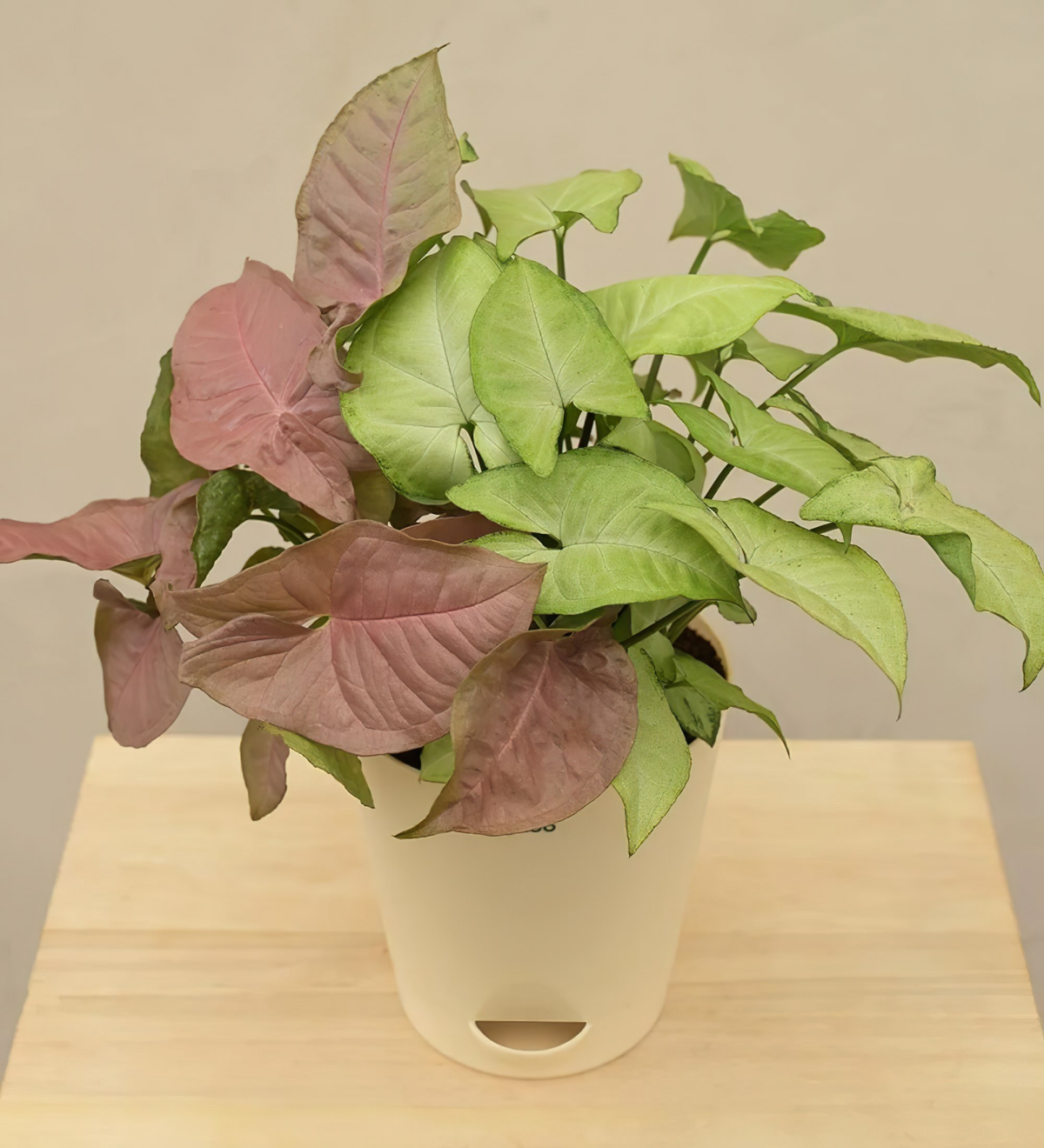
Then, just pop the cutting in a jar of water, making sure the node is submerged. Put it in a bright spot and change the water every few days. In a couple of weeks, you’ll see little white roots start to sprout. Once those roots are an inch or two long, you can plant your new baby in a small pot of soil.
Troubleshooting: What Your Plant is Trying to Tell You
Your plant will tell you when something’s wrong. You just have to learn the language. Here are the most common complaints:
- What you see: Yellowing leaves, especially lower ones.
What it means: Almost always, this is overwatering. The soil is too soggy for too long.
The fix: Let the soil dry out more between waterings. Make sure the pot has good drainage. That yellow leaf won’t recover, so just snip it off. - What you see: Brown, crispy leaf tips or edges.
What it means: Usually low humidity or inconsistent watering (letting it get way too dry, then flooding it). It can also be a buildup of minerals from hard tap water.
The fix: Try a humidifier or a pebble tray. Be more consistent with your watering routine. If you suspect hard water, try using filtered or rainwater. - What you see: New leaves are more green than pink.
What it means: This is a cry for more light! It’s producing more green chlorophyll to survive.
The fix: Move it to a brighter location, but remember, no direct, scorching sun. - What you see: Pests like spider mites or mealybugs.
What it means: You have some unwanted visitors. From my experience, panic is the first reaction, but it’s fixable. I once found mealybugs—those gross little white cottony things—tucked into the new leaves of a prized plant. My stomach dropped. But all I did was grab a cotton swab, dip it in rubbing alcohol (a budget-friendly fix!), and wipe every single one of them off. For a bigger outbreak, a good insecticidal soap from the garden center works wonders. The key is to act fast and isolate the plant so they don’t spread.
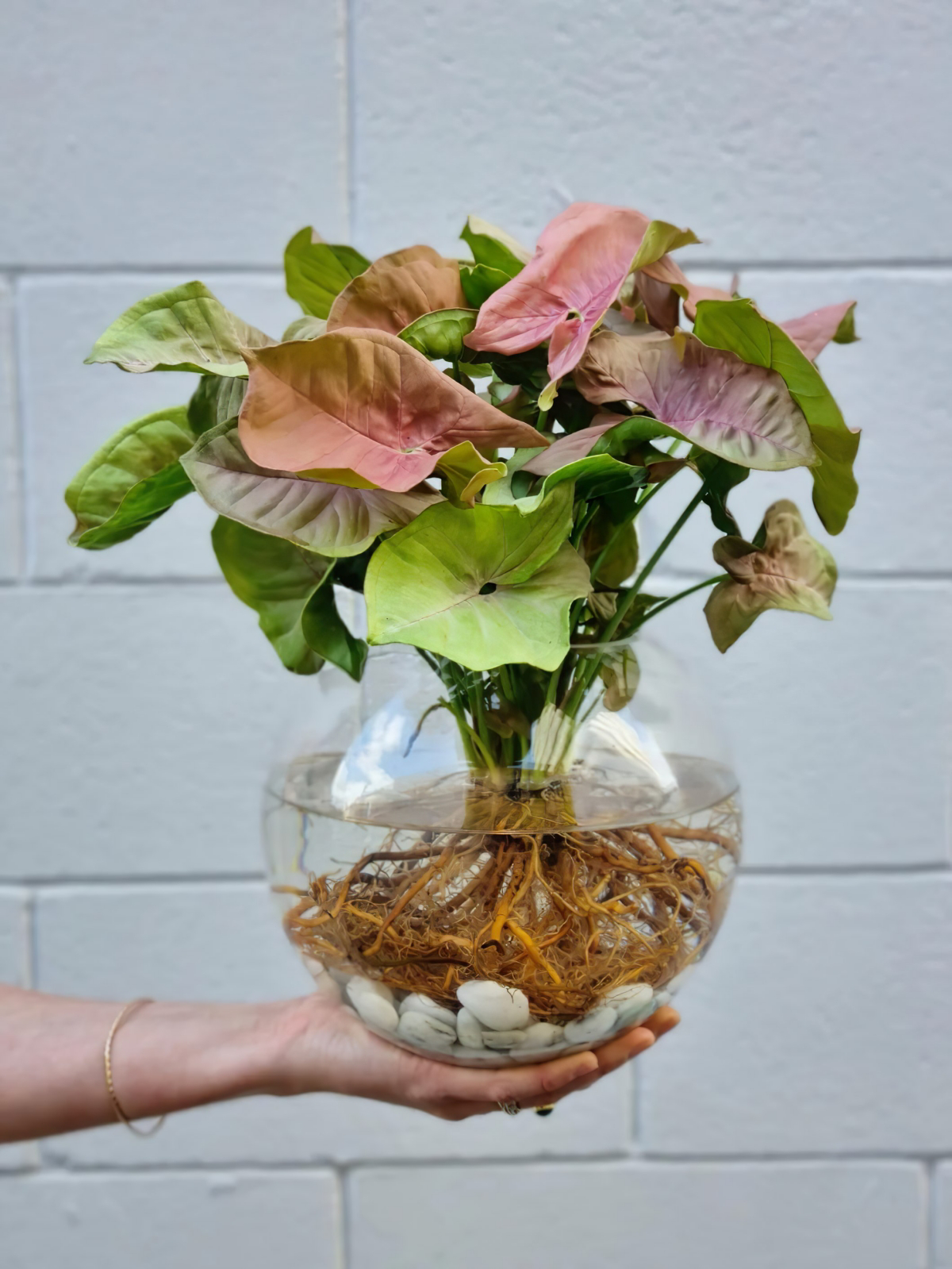
A Critical Safety Warning: This Plant is Toxic
Okay, let’s be very clear about this. All parts of the Syngonium plant are toxic if chewed on or eaten. They contain tiny, needle-like crystals that cause immediate and painful irritation and swelling in the mouth and throat. It’s the plant’s defense mechanism.
This is a serious issue if you have curious pets (cats and dogs especially) or small children. Being a responsible plant parent means keeping them safe. Place this plant on a high shelf or in a hanging basket, well out of reach. If you ever suspect a pet or child has chewed on it, contact your vet or poison control right away.
A Final Word
This beautiful pink plant is so much more than just décor. It’s a living thing that responds directly to your care. It teaches you to be observant and rewards your effort with stunning growth. So don’t be afraid to snip it, don’t panic over a yellow leaf, and just enjoy the process. Give it the right start, and it’ll be a beautiful friend for years to come.
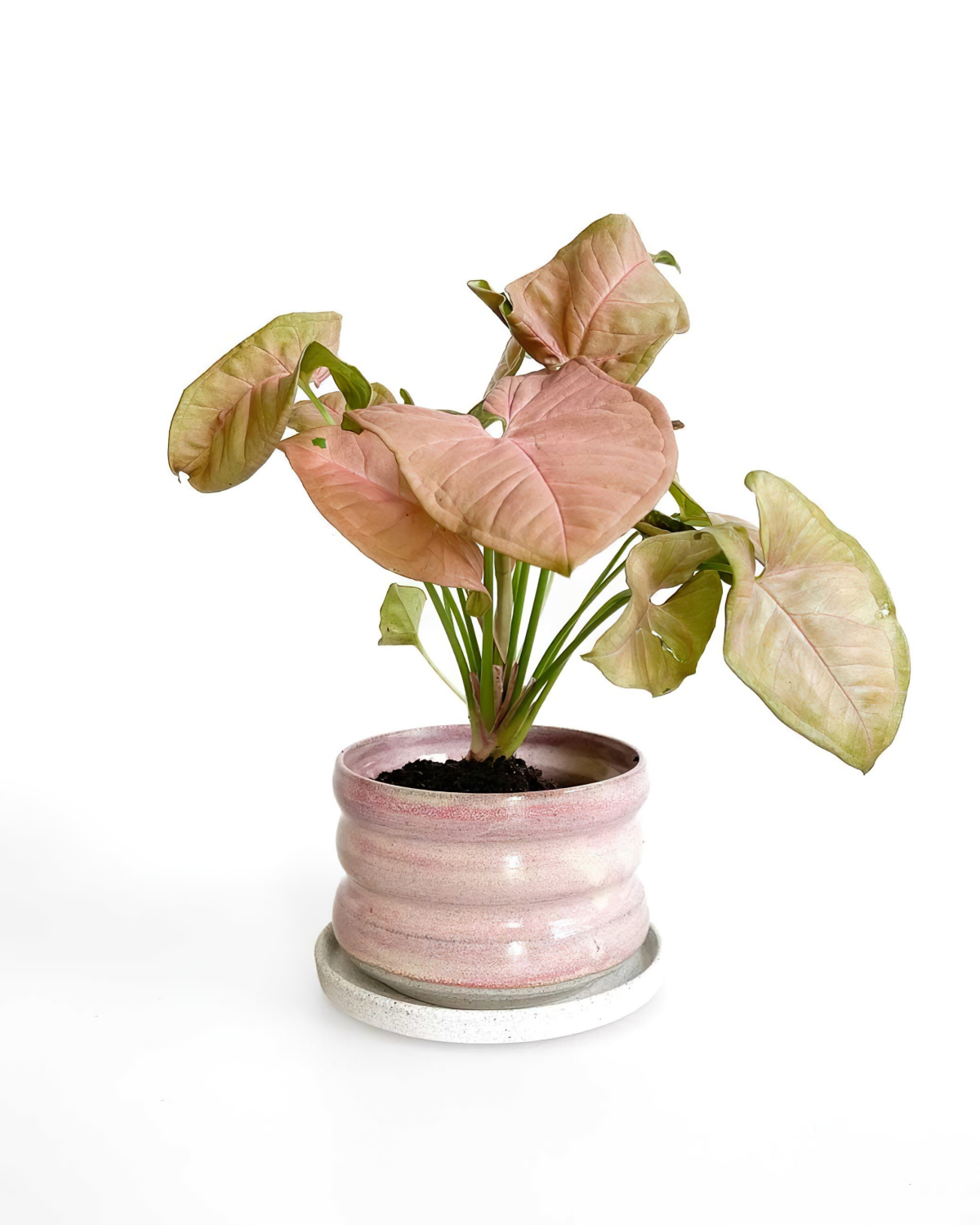
Galerie d’inspiration
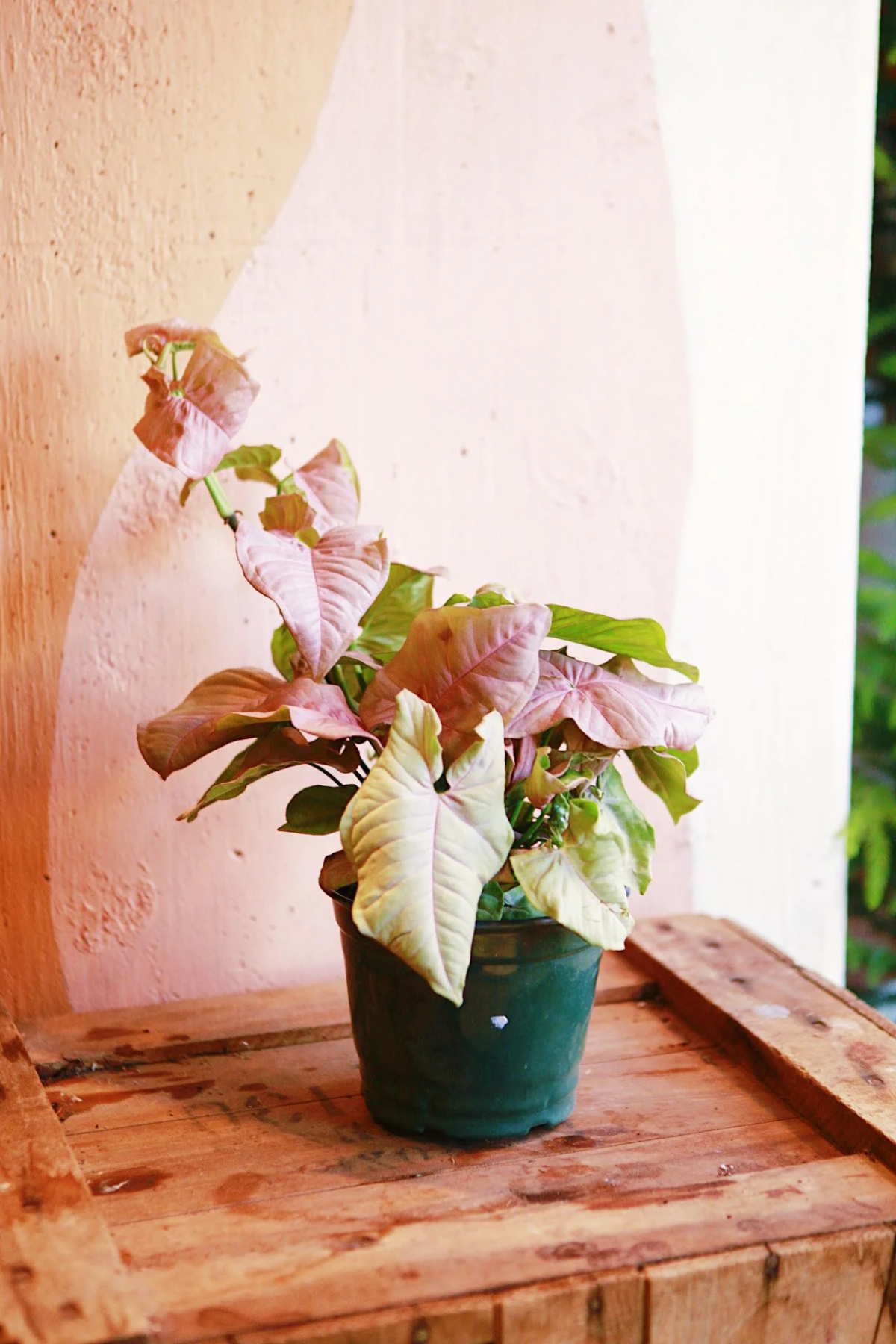
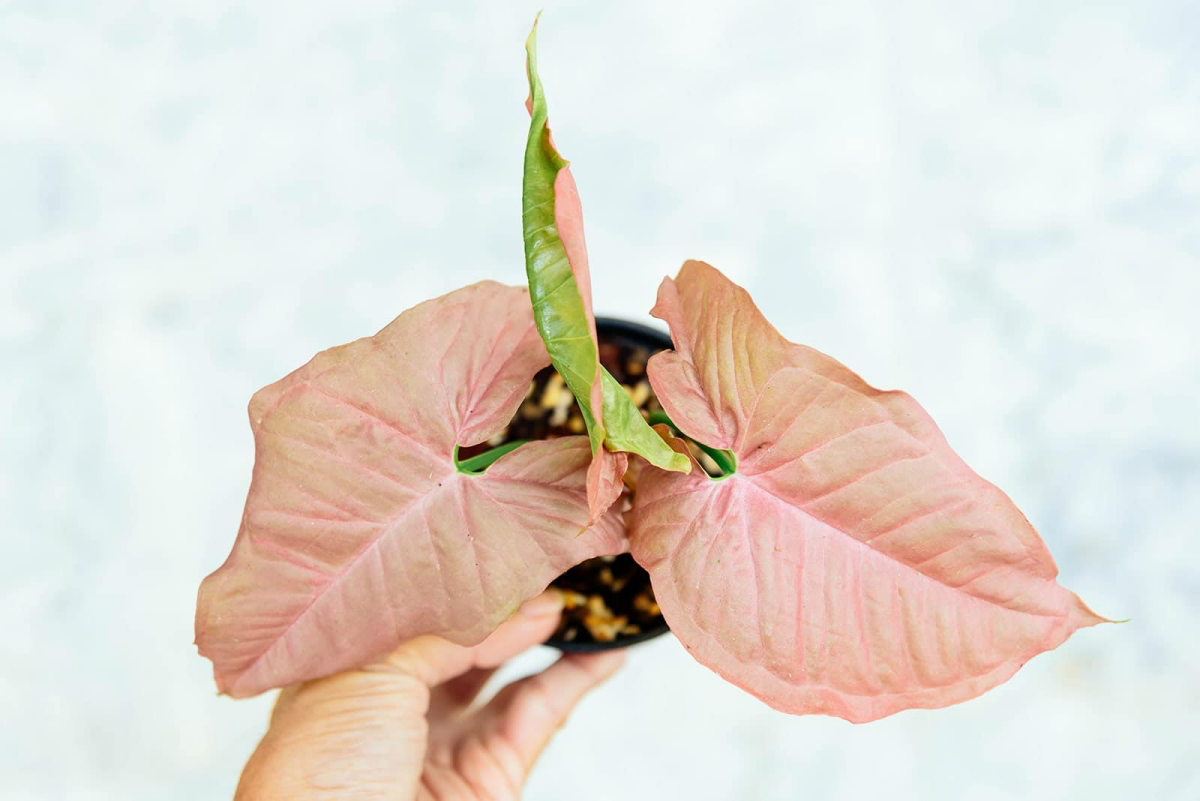
- Create lush, full pots from a single plant.
- Share your beautiful Syngonium with friends for free.
- Watch new roots magically appear in just a few weeks.
The secret? Water propagation. Simply snip a stem below a node (the little bump where a leaf grows), place it in a glass of water, and wait. It’s one of the most rewarding and simple ways to multiply your collection.
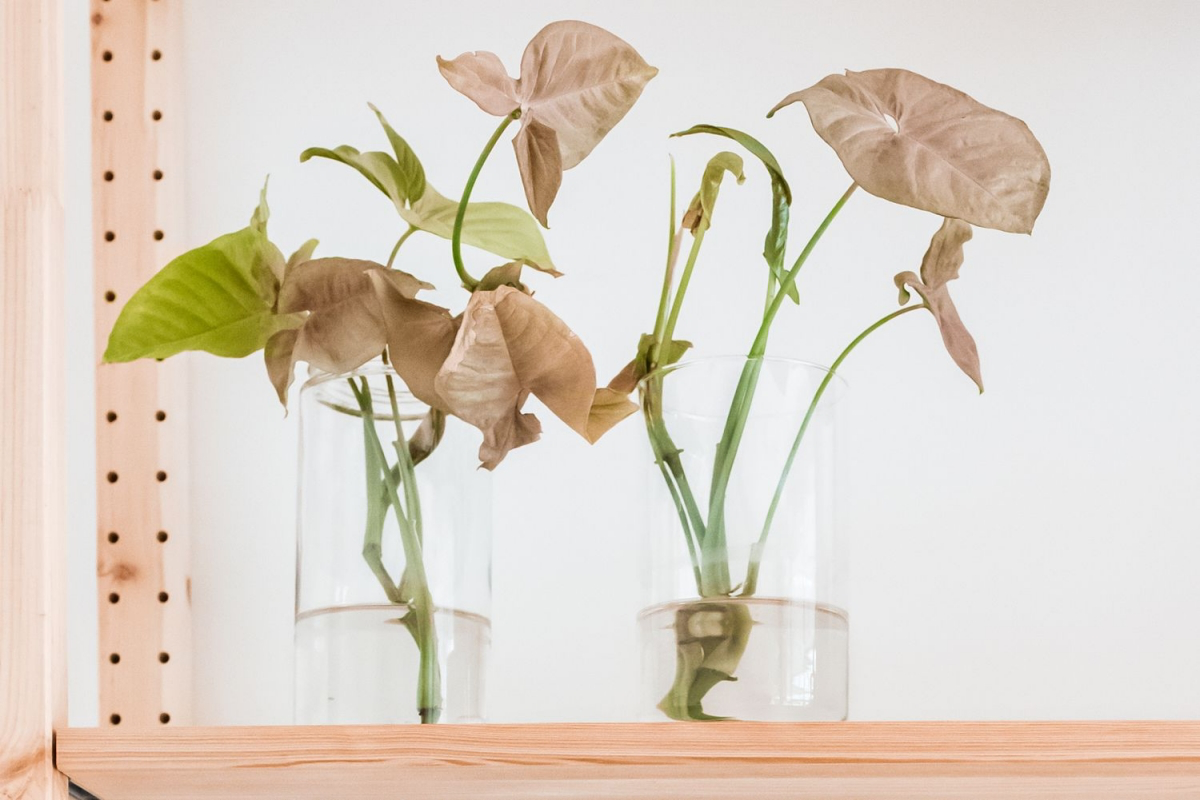
Did you know? The vibrant pink in many Syngonium cultivars is not a stable genetic trait. The plant needs to be ‘stressed’ with perfect levels of bright, indirect light to produce and maintain its signature color.
This is why a Pink Syngonium might slowly revert to green if kept in a lower-light corner. It’s not dying; it’s just conserving energy by producing more chlorophyll. Think of its color as a living light meter for your home.

My Pink Syngonium’s new leaves are small and the pink is pale. What’s wrong?
This often points to a need for more nutrients. During the growing season (spring and summer), your plant is working hard. Support it with a gentle, balanced liquid fertilizer every 4-6 weeks. A formula like Schultz Plant Food Plus (10-15-10) diluted to half-strength is perfect. It provides the nitrogen for growth and the phosphorus/potassium to support robust color and root health without being too harsh.

Achieve that perfect ‘jungle’ look by pairing your Pink Syngonium with complementary textures and colors. Its soft pink arrow-shaped leaves create a stunning contrast against the deep, dark green foliage of a ZZ Plant (Zamioculcas zamiifolia) or the dramatic, silvery patterns of a Scindapsus pictus ‘Argyraeus’. The combination makes the pink pop even more.
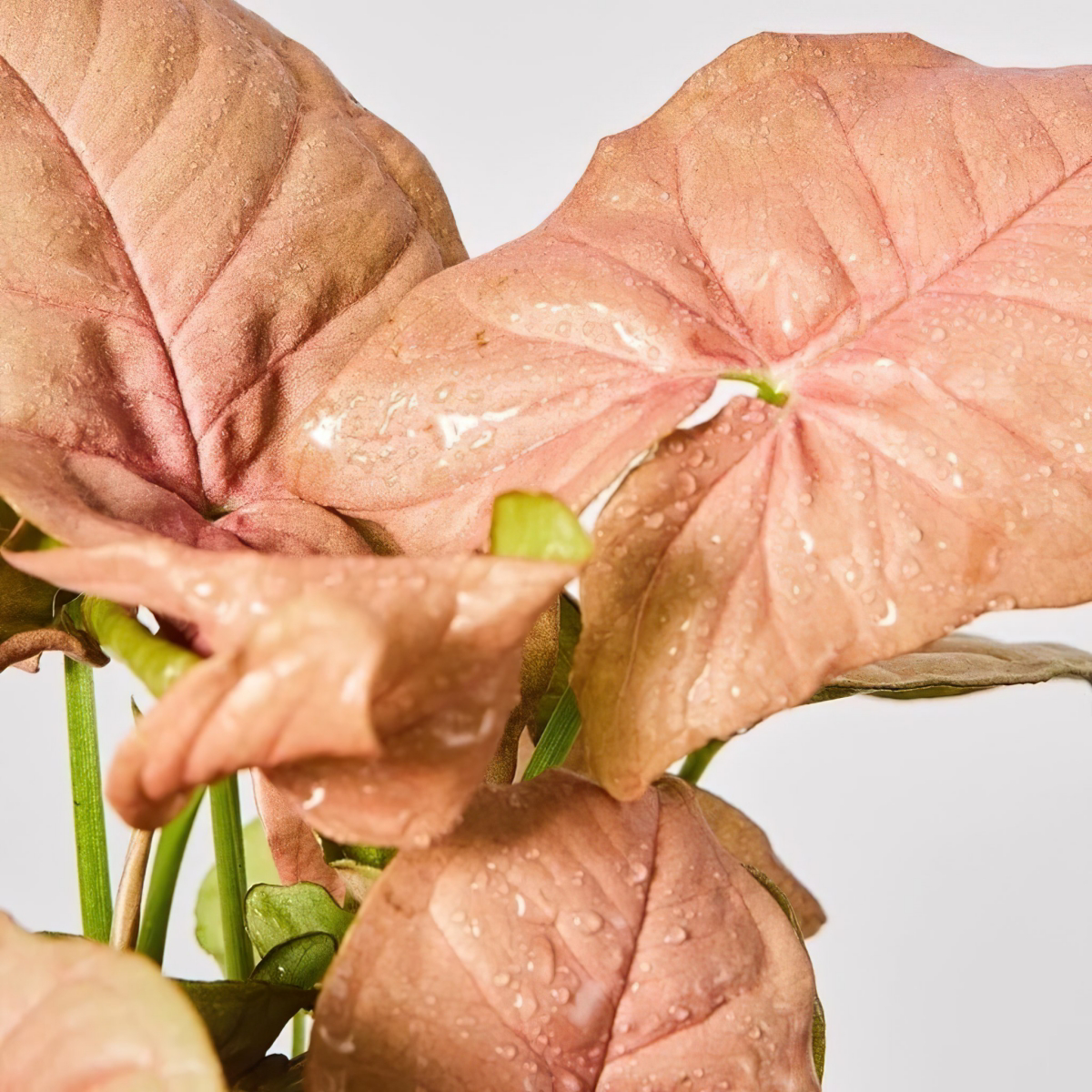
- Yellowing leaves starting from the bottom? Likely overwatering and potential root rot. Let the soil dry out significantly before watering again.
- Whole plant wilted and droopy with dry soil? It’s thirsty! Give it a good soak.
- Brown, crispy leaf edges? This is rarely a watering issue. It’s your plant’s way of screaming for more humidity!
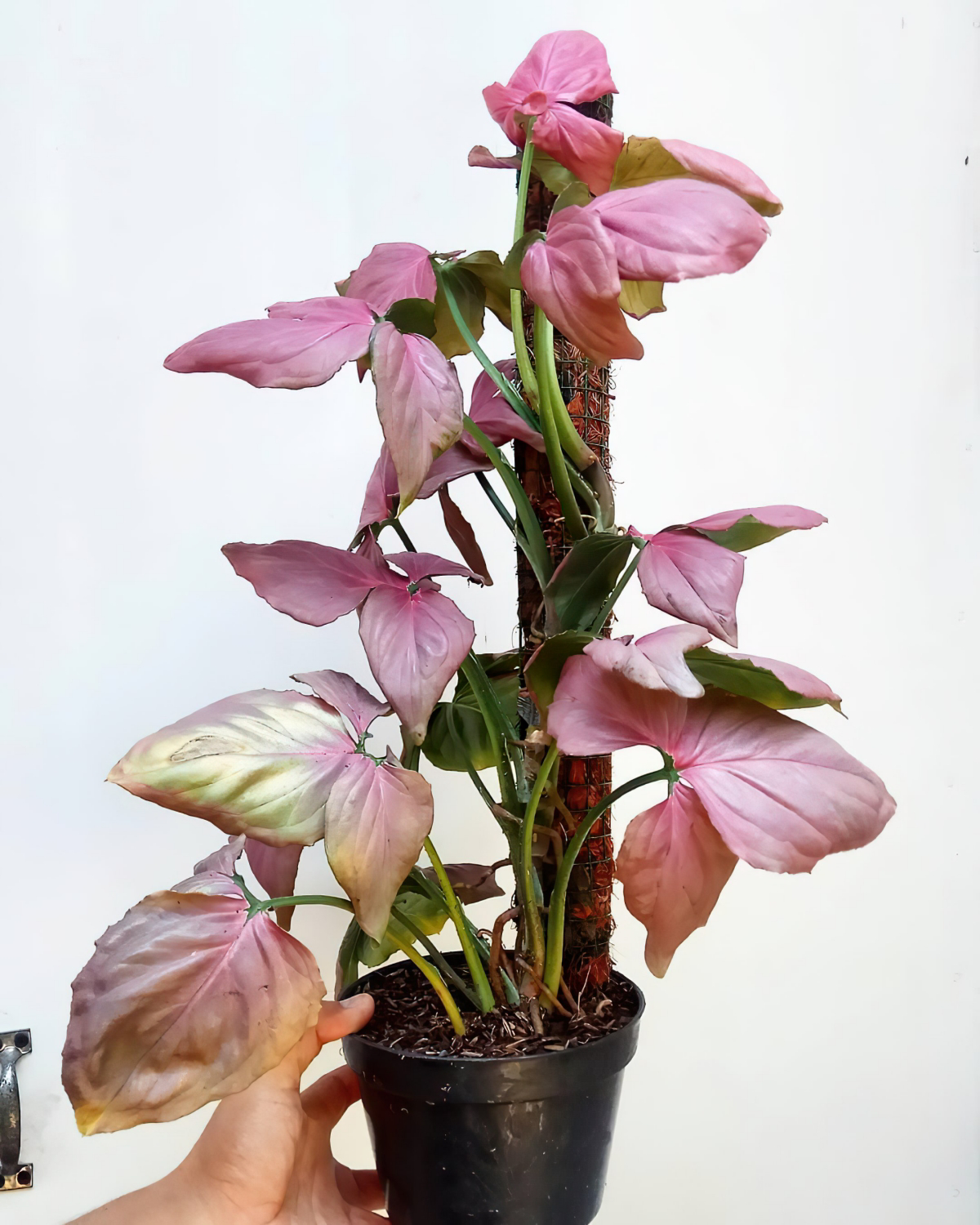
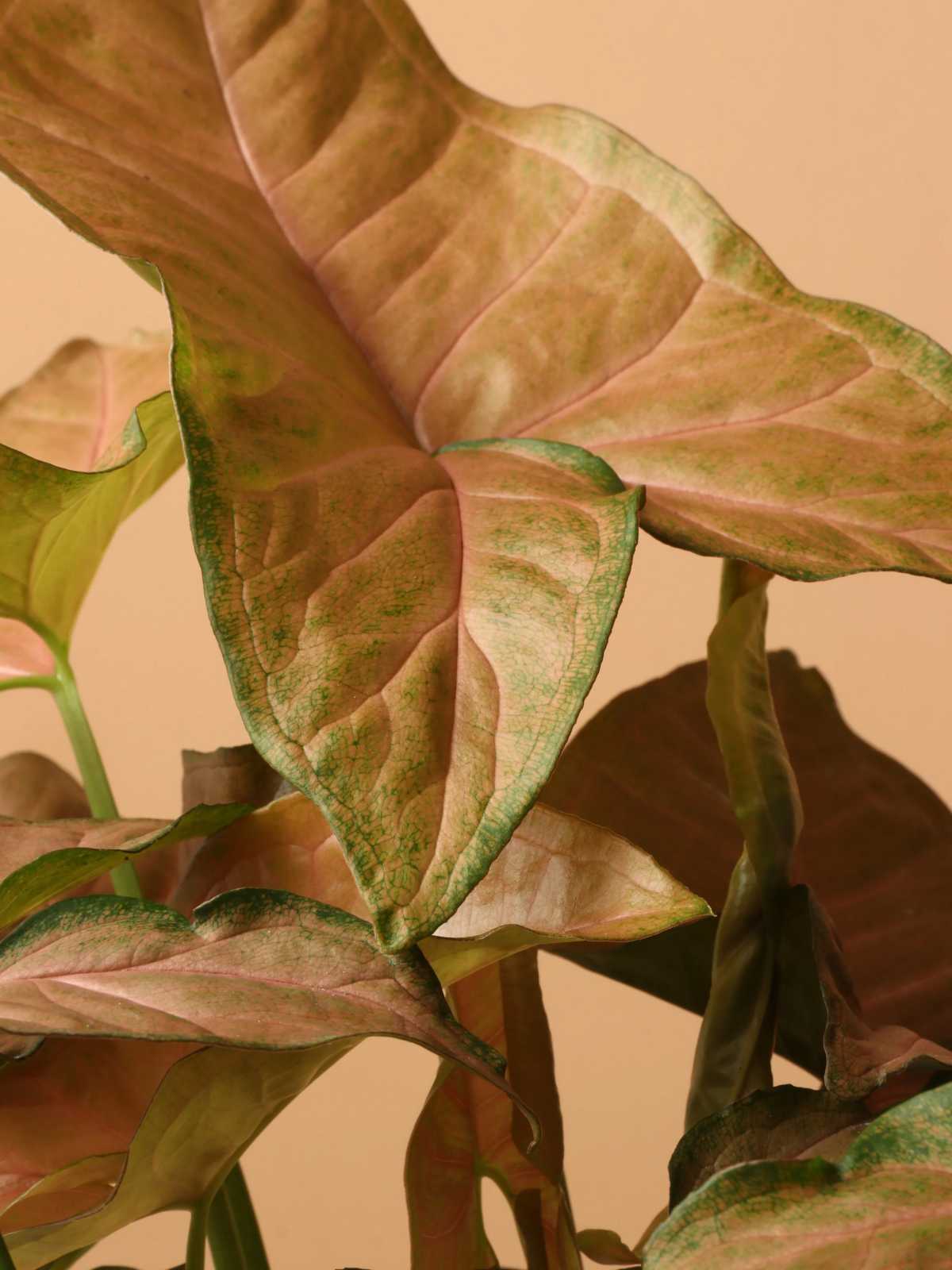
‘Neon Robusta’: This variety is the showstopper, boasting an intense, almost electric bubblegum pink across the entire leaf. It demands bright, indirect light to maintain this shocking color.
‘Pink Allusion’: This one is more subtle and complex. The leaves have a creamy, light-pink base with darker pink veins and green edges, giving it a softer, more pastel appearance.
Both are beautiful, but your choice depends on whether you want a loud pop of color or a more delicate touch.
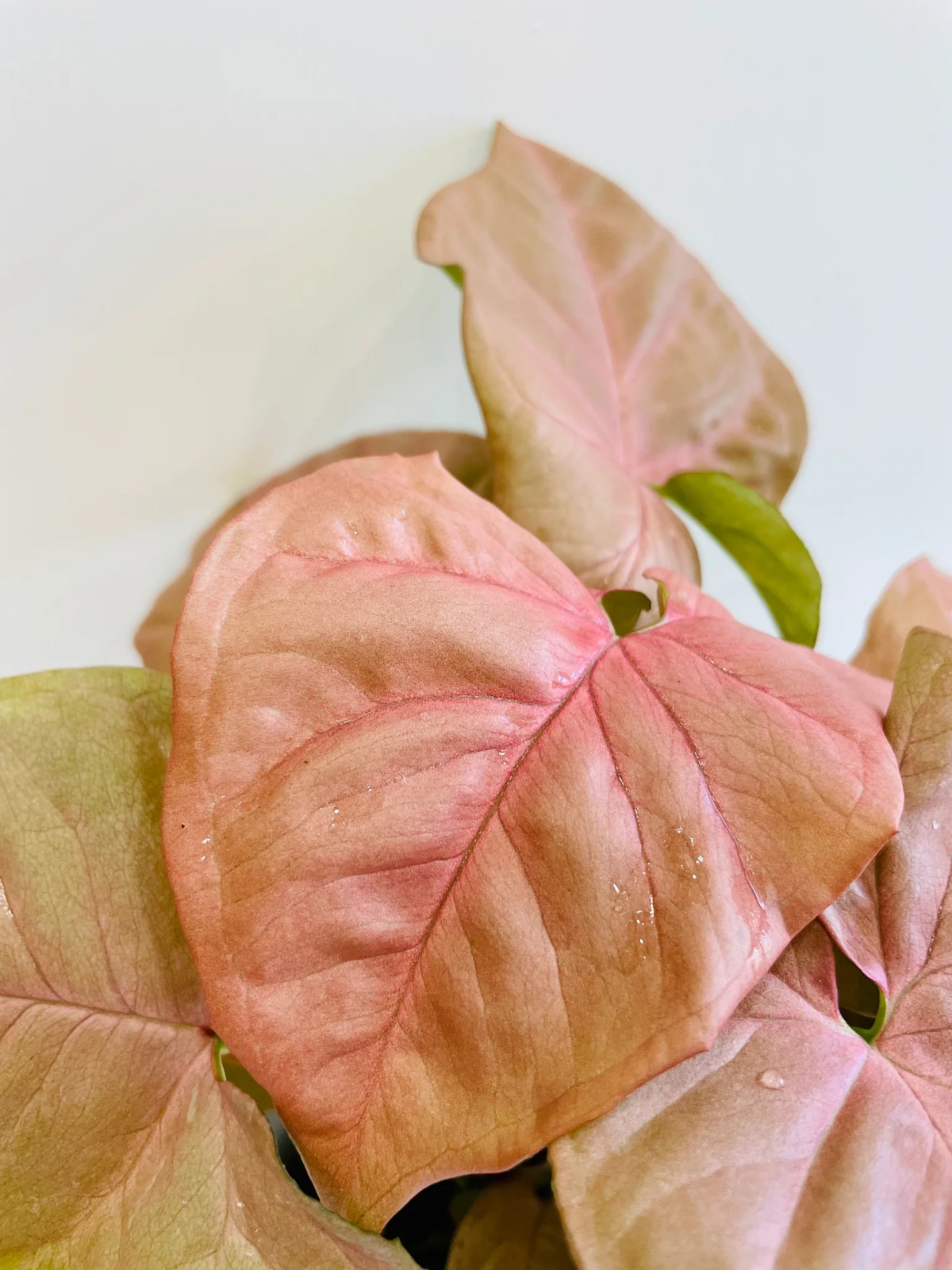
Syngonium podophyllum contains insoluble calcium oxalate crystals, making it toxic to cats, dogs, and humans if ingested.
While beautiful, it’s crucial to be mindful of placement if you have curious pets or small children. Ingestion can cause oral irritation, pain, swelling of the mouth and throat, and vomiting. Keep your Pink Syngonium on a high shelf or in a hanging planter where it can be admired safely from a distance.
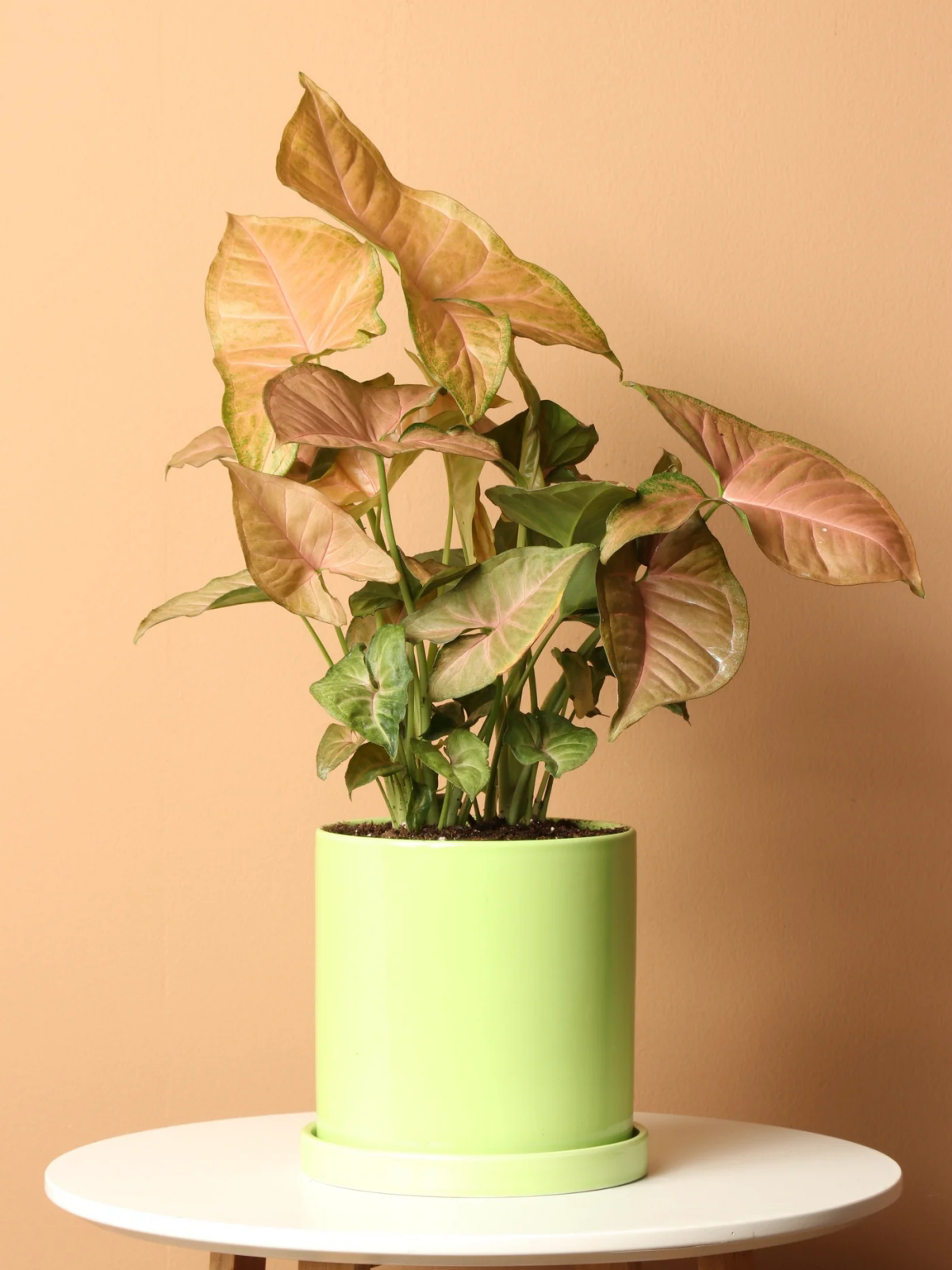
Want a fuller, bushier plant without spending more on a larger pot? The power is in your pruners. When you trim the long, vining stems, you encourage the plant to push out new growth from its base. Don’t throw away the cuttings! As we’ve seen, they are incredibly easy to propagate into new plants that you can add back to the original pot for a super lush look.
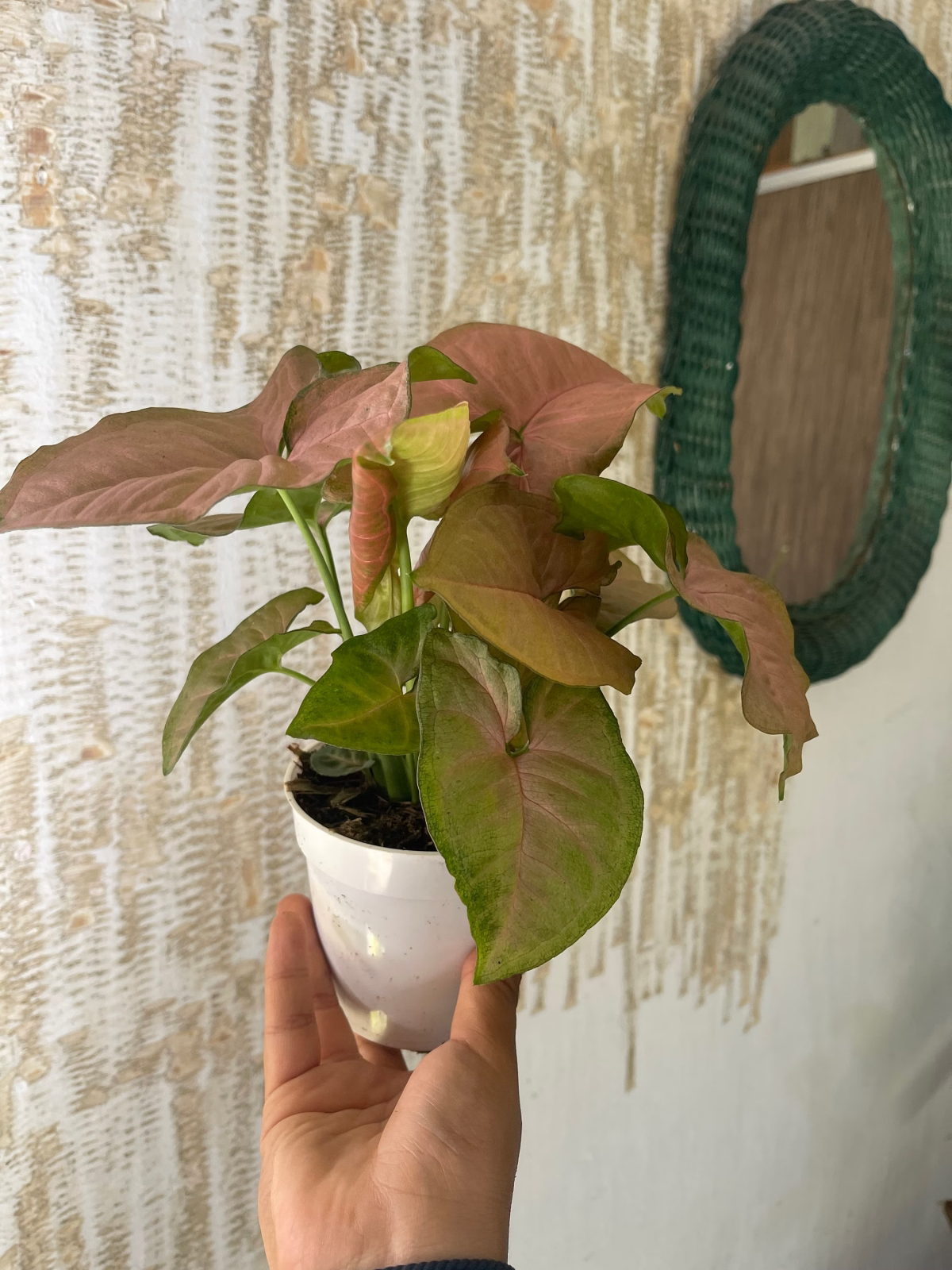
The choice of how to display your Syngonium dramatically changes its personality. For a mature, elegant look, give it a moss pole, like those from Mossify, to climb. This encourages larger leaves and mimics its natural growth habit. For a more bohemian, carefree vibe, let its vines cascade from a hanging basket or the edge of a bookshelf, creating a lush, trailing curtain of pink.
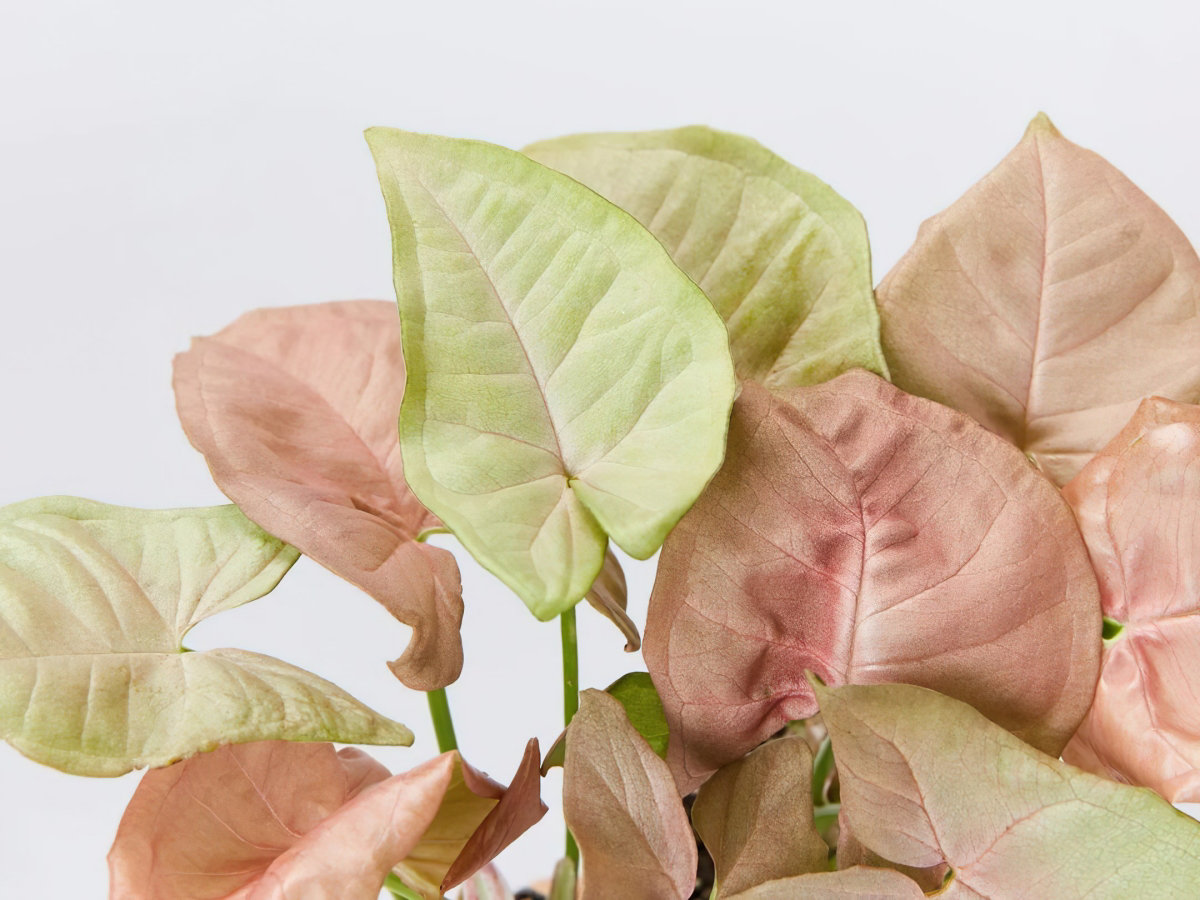
Important point: The secret to happy Pink Syngoniums is a chunky, airy soil mix. Standard potting soil is too dense, holds too much water, and can easily lead to root rot. Your plant’s roots need to breathe!
You don’t need fancy equipment to boost humidity. Simply grouping your Pink Syngonium with other tropical plants creates a small, humid microclimate as they all release moisture through transpiration. It’s a natural, beautiful, and effective way to keep those leaves from getting crispy edges.










